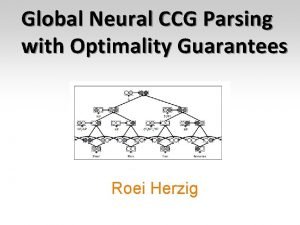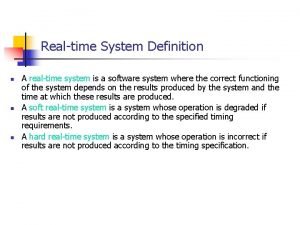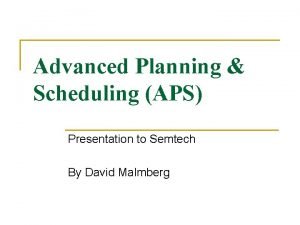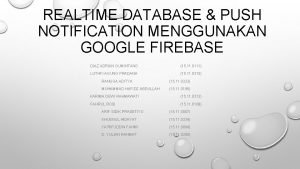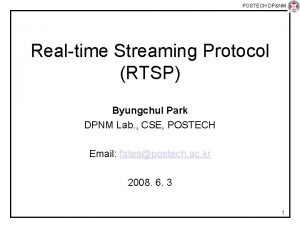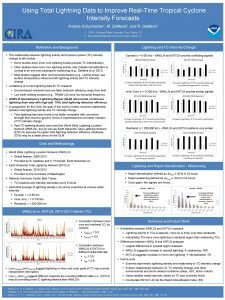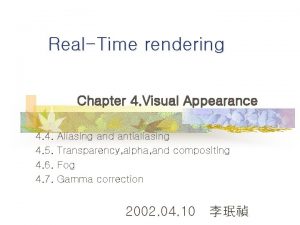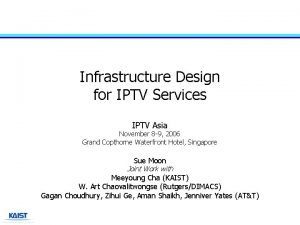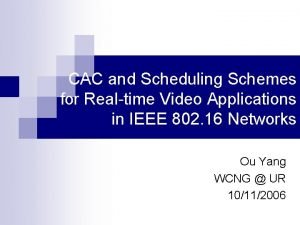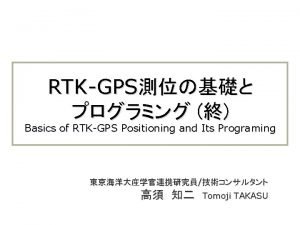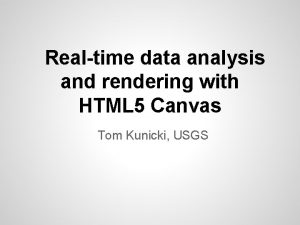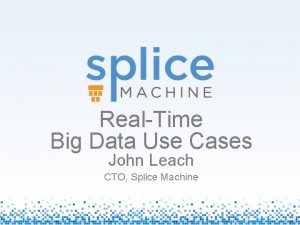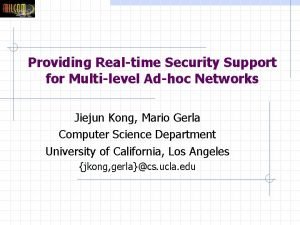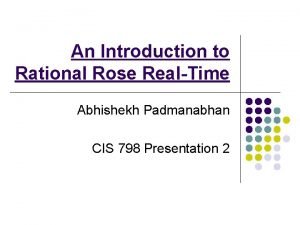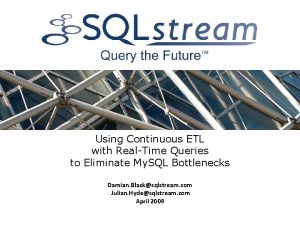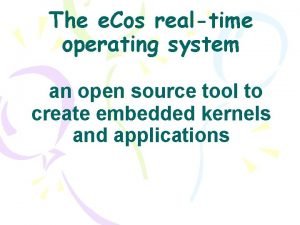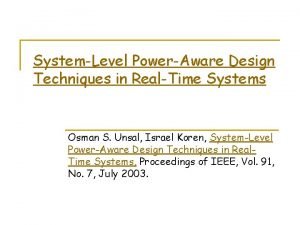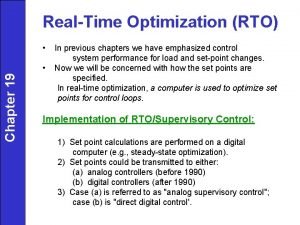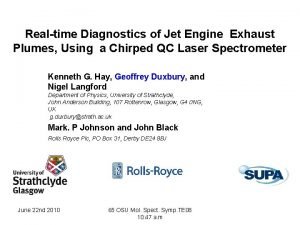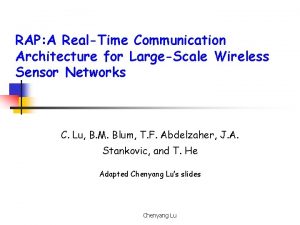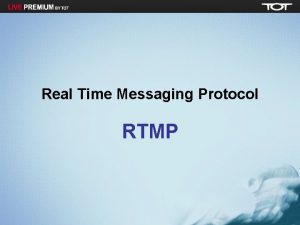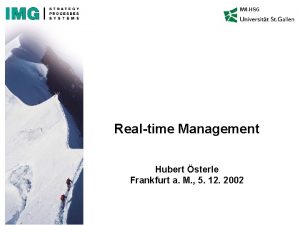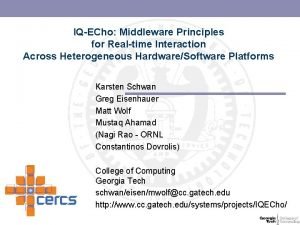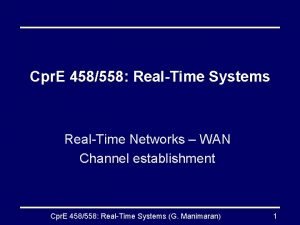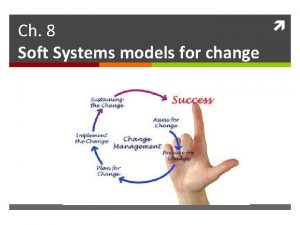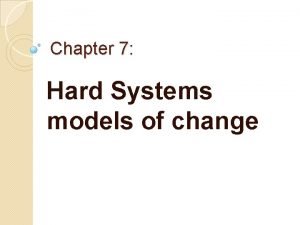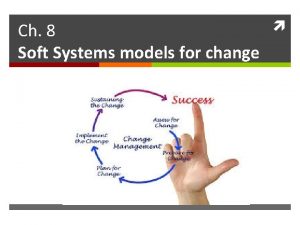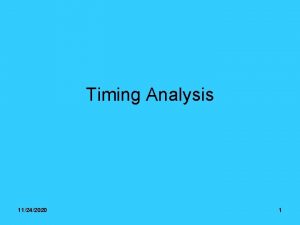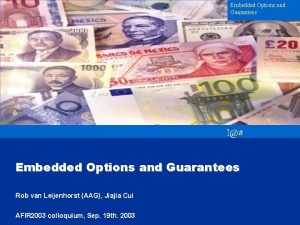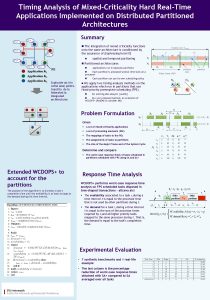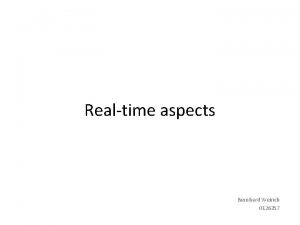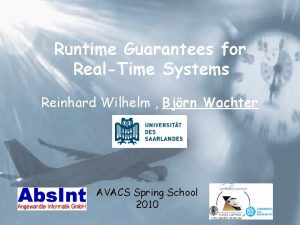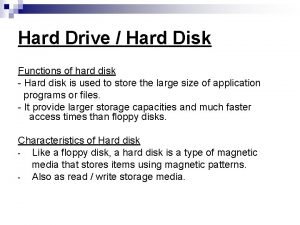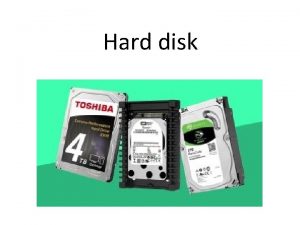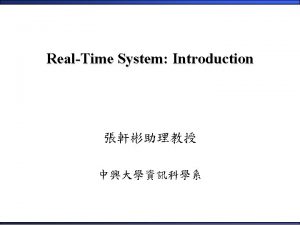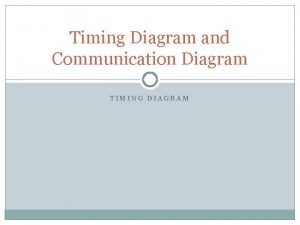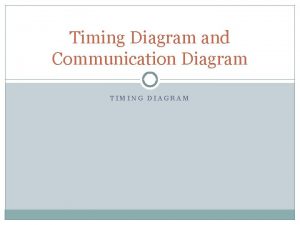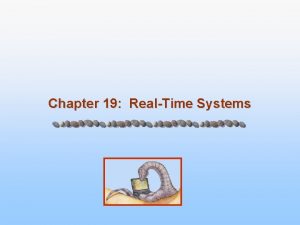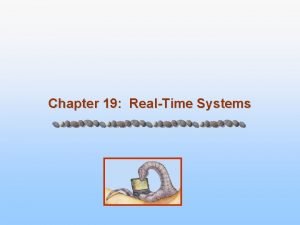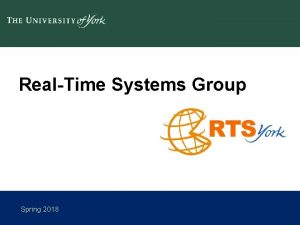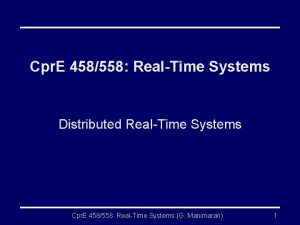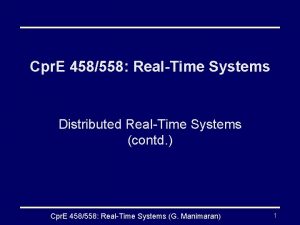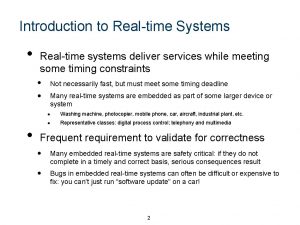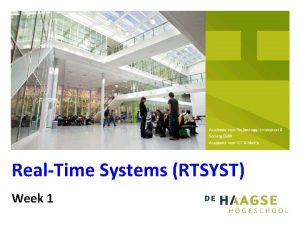Timing Analysis timing guarantees for hard realtime systems












































![Contribution to WCET while. . . do [max n] . . . ref to Contribution to WCET while. . . do [max n] . . . ref to](https://slidetodoc.com/presentation_image_h2/d5c726b893d45b49e0fa4ccda52a650a/image-45.jpg)

















![Value Analysis II D 1: [-4, 4], A[0 x 1000, 0 x 1000] move. Value Analysis II D 1: [-4, 4], A[0 x 1000, 0 x 1000] move.](https://slidetodoc.com/presentation_image_h2/d5c726b893d45b49e0fa4ccda52a650a/image-63.jpg)







- Slides: 70

Timing Analysis - timing guarantees for hard real-time systems- Reinhard Wilhelm Saarland University Saarbrücken

Structure of the Lecture 1. 2. 3. 4. 5. 6. 7. 8. – – Introduction Static timing analysis the problem our approach the success tool architecture Cache analysis Pipeline analysis Value analysis Worst-case path determination Conclusion Further readings

Industrial Needs Hard real-time systems, often in safety-critical applications abound – Aeronautics, automotive, train industries, manufacturing control Sideairbag in car, Reaction in <10 m. Sec Wing vibration of airplane, sensing every 5 m. Sec crankshaft-synchronous tasks have very tight deadlines, ~45 u. S

Static Timing Analysis Embedded controllers are expected to finish their tasks reliably within time bounds. The problem: Given 1. a software to produce some reaction, 2. a hardware platform, on which to execute the software, 3. required reaction time. Derive: a guarantee for timeliness.

What does Execution Time Depend on? • the input – this has always been so and will remain so, • the initial execution state of the platform – this is (relatively) new, • interferences from the environment – this depends on whether the system design admits it (preemptive scheduling, interrupts). Caused by caches, pipelines, speculation etc. Explosion of the space of inputs and initial states no exhaustive approaches feasible. “external” interference as seen from analyzed task

Modern Hardware Features • Modern processors increase (average-case) performance by using: Caches, Pipelines, Branch Prediction, Speculation • These features make bounds computation difficult: Execution times of instructions vary widely – Best case - everything goes smoothly: no cache miss, operands ready, needed resources free, branch correctly predicted – Worst case - everything goes wrong: all loads miss the cache, resources needed are occupied, operands are not ready – Span may be several hundred cycles

Access Times x = a + b; MPC 5 xx The threat: Over-estimation by a factor of 100 LOAD r 2, _a LOAD r 1, _b ADD r 3, r 2, r 1 PPC 755

Notions in Timing Analysis Hard or impossible to determine Determine upper bounds instead

Timing Analysis A success story formal methods!

ai. T WCET Analyzer IST Project DAEDALUS final review report: "The Abs. Int tool is probably the best of its kind in the world and it is justified to consider this result as a breakthrough. ” Several time-critical subsystems of the Airbus A 380 have been certified using ai. T; ai. T is the only validated tool for these applications.

cache-miss penalty over-estimation Tremendous Progress 200 during the past 13 Years The explosion of penalties has been compensated by the improvement of the analyses! 60 25 20 -30% 30 -50% 25% 10% 4 1995 Lim et al. 2002 Thesing et al. 2005 Souyris et al.

High-Level Requirements for Timing Analysis • Upper bounds must be safe, i. e. not underestimated • Upper bounds should be tight, i. e. not far away from real execution times • Analogous for lower bounds • Analysis effort must be tolerable Note: all analyzed programs are terminating, loop bounds need to be known no decidability problem, but a complexity problem!

Our Approach • End-to-end measurement is not possible because of the large state space. • We compute bounds for the execution times of instructions and basic blocks and determine a longest path in the basic-block graph of the program. • The variability of execution times – may cancel out in end-to-end measurements, but this is hard to quantify, – exists “in pure form” on the instruction level.

Timing Accidents and Penalties Timing Accident – cause for an increase of the execution time of an instruction Timing Penalty – the associated increase • Types of timing accidents – – – Cache misses Pipeline stalls Branch mispredictions Bus collisions Memory refresh of DRAM TLB miss

Execution Time is History-Sensitive Contribution of the execution of an instruction to a program‘s execution time • depends on the execution state, e. g. the time for a memory access depends on the cache state • the execution state depends on the execution history • needed: an invariant about the set of execution states produced by all executions reaching a program point. • We use abstract interpretation to compute these invariants.

Deriving Run-Time Guarantees • Our method and tool, ai. T, derives Safety Properties from these invariants : Certain timing accidents will never happen. Example: At program point p, instruction fetch will never cause a cache miss. • The more accidents excluded, the lower the upper bound. Murphy’s invariant Fastest Variance of execution times Slowest

Abstract Interpretation in Timing Analysis • Abstract interpretation is always based on the semantics of the analyzed language. • A semantics of a programming language that talks about time needs to incorporate the execution platform! • Static timing analysis is thus based on such a semantics.

The Architectural Abstraction inside the Timing Analyzer Timing analyzer Architectural abstractions Value Analysis, Control-Flow Analysis, Loop-Bound Analysis abstractions of the processor’s arithmetic Cache Pipeline Abstraction

Abstract Interpretation in Timing Analysis Determines • invariants about the values of variables (in registers, on the stack) – to compute loop bounds – to eliminate infeasible paths – to determine effective memory addresses • invariants on architectural execution state – Cache contents – Pipeline states predict hits & misses predict or exclude pipeline stalls

Tool Architecture Abstract Interpretations Abstract Interpretation Integer Linear Programming

Tool Architecture Abstract Interpretations Caches Abstract Interpretation Integer Linear Programming

Caches: Small & Fast Memory on Chip • Bridge speed gap between CPU and RAM • Caches work well in the average case: – Programs access data locally (many hits) – Programs reuse items (instructions, data) – Access patterns are distributed evenly across the cache • Cache performance has a strong influence on system performance!

Caches: How they work CPU: read/write at memory address a, – sends a request for a to bus m Cases: • Hit: a – Block m containing a in the cache: request served in the next cycle • Miss: – Block m not in the cache: m is transferred from main memory to the cache, m may replace some block in the cache, request for a is served asap while transfer still continues

Replacement Strategies • Several replacement strategies: LRU, PLRU, FIFO, . . . determine which line to replace when a memory block is to be loaded into a full cache (set)

LRU Strategy • Each cache set has its own replacement logic => Cache sets are independent: Everything explained in terms of one set • LRU-Replacement Strategy: – Replace the block that has been Least Recently Used – Modeled by Ages • Example: 4 -way set associative cache age Access m 4 (miss) Access m 1 (hit) Access m 5 (miss) 0 1 2 3 m 0 m 1 m 2 m 3 m 4 m 1 m 5 m 0 m 4 m 1 m 2 m 0 m 2 m 4 m 0

Cache Analysis How to statically precompute cache contents: • Must Analysis: For each program point (and context), find out which blocks are in the cache prediction of cache hits • May Analysis: For each program point (and context), find out which blocks may be in the cache Complement says what is not in the cache prediction of cache misses • In the following, we consider must analysis until otherwise stated.

(Must) Cache Analysis • Consider one instruction in the program. • There may be many paths leading to this instruction. • How can we compute whether a will always be in cache independently of which path execution takes? load a Question: Is the access to a always a cache hit?

Determine Cache-Information (abstract must-cache states) at each Program Point youngest age - 0 {x} {a, b} oldest age - 3 Interpretation of this cache information: describes the set of all concrete cache states in which x, a, and b occur • x with an age not older than 1 • a and b with an age not older than 2, Cache information contains 1. only memory blocks guaranteed to be in cache. 2. they are associated with their maximal age.

Cache Analysis – how does it work? • How to compute for each program point an abstract cache state representing a set of memory blocks guaranteed to be in cache each time execution reaches this program point? • Can we expect to compute the largest set? • Trade-off between precision and efficiency – quite typical for abstract interpretation

(Must) Cache analysis of a memory access x a b y concrete transfer function (cache) access to a a x b y abstract transfer function (analysis) {x} {a, b} After the access to a, a is the youngest memory access to a block in cache, and we must assume that x has aged. What about b? {a} {b, x}

Combining Cache Information • Consider two control-flow paths to a program point: – for one, prediction says, set of memory blocks S 1 in cache, – for the other, the set of memory blocks S 2. – Cache analysis should not predict more than S 1 S 2 after the merge of paths. – the elements in the intersection should have their maximal age from S 1 and S 2. • Suggests the following method: Compute cache information along all paths to a program point and calculate their intersection – but too many paths! • More efficient method: – combine cache information on the way, – iterate until least fixpoint is reached. • There is a risk of losing precision, not in case of distributive transfer functions.

What happens when control-paths merge? We can guarantee this content {c} {e} {a} {d} {a} { c, f } {d} on this path. Which content {can } we { } guarantee a, c path? on{ this } {d} We can guarantee this content on this path. “intersection + maximal age” combine cache information at each control-flow merge point

Must-Cache and May-Cache- Information • The presented cache analysis is a Must Analysis. It determines safe information about cache hits. Each predicted cache hit reduces the upper bound. • We can also perform a May Analysis. It determines safe information about cache misses Each predicted cache miss increases the lower bound.

(May) Cache analysis of a memory access {y} {x} {a, b} {z} access to a {a} {y} {x} {b, z} Why? After the access to a a is the youngest memory block in cache, and we must assume that x, y and b have aged.

Cache Analysis: Join (may) {a} { c, f } {d} Join (may) {c} {e} {a} {d} “union + minimal age” { a, c } { e} {f} {d}

Result of the Cache Analyses Categorization of memory references

Abstract Domain: Must Cache Representing sets of concrete caches by their description concrete caches z s x a z s x t s z x t x s z t Abstraction abstract cache z t x s {} {} {z, x} {s}

Abstract Domain: Must Cache Sets of concrete caches described by an abstract cache concrete caches Concretization abstract cache z, x {s { {} {} {z, x} {s} remaining line filled up with any other block over-approximation! and form a Galois Connection

Abstract Domain: May Cache concrete caches z s x a z s x t Abstraction abstract cache s z x t x s z t x s {zx}, s, {t} {} {a}

Abstract Domain: May Cache concrete caches {z, s, x} {z, s, x, t} {z, s, x, t, a} Concretization abstract cache {z, s, x} {t} {} {a} abstract may-caches say what definitely is not in cache and what the minimal age of those is that may be in cache.

Galois connection – Relating Semantic Domains • • • Lattices C, A two monotone functions ® and ° Abstraction: ®: C A Concretization °: A C (®, °) is a Galois connection if and only if ° ® w. C id. C and ® ° v. A id. A Switching safely between concrete and abstract domains, possibly losing precision

Abstract Domain Must Cache ° ® w id C C concrete caches z s x a z s x t z, x s z x t x s z t x s {s { remaining line filled up with any memory block abstract cache {} {} {z, x} {s} safe, but may lose precision

Lessons Learned • Cache analysis, an important ingredient of static timing analysis, provides for abstract domains, • which proved to be sufficiently precise, • have compact representation, • have efficient transfer functions, • which are quite natural.

Problem Solved? • We have shown a solution for LRU caches. • LRU-cache analysis works smoothly – Favorable „structure“ of domain – Essential information can be summarized compactly • LRU is the best strategy under several aspects – performance, predictability, sensitivity • … and yet: LRU is not the only strategy – Pseudo-LRU (Power. PC 755 @ Airbus) – FIFO – worse under almost all aspects, but average-case performance!
![Contribution to WCET while do max n ref to Contribution to WCET while. . . do [max n] . . . ref to](https://slidetodoc.com/presentation_image_h2/d5c726b893d45b49e0fa4ccda52a650a/image-45.jpg)
Contribution to WCET while. . . do [max n] . . . ref to s. . . od loop time n tmiss n thit tmiss (n 1) thit (n 1) tmiss

Contexts Cache contents depends on the Context, i. e. calls and loops First Iteration loads the cache => Intersection loses most of the information! while cond do join (must)

Distinguish basic blocks by contexts • Transform loops into tail recursive procedures • Treat loops and procedures in the same way • Use interprocedural analysis techniques, VIVU – virtual inlining of procedures – virtual unrolling of loops • Distinguish as many contexts as useful – 1 unrolling for caches – 1 unrolling for branch prediction (pipeline)

Tool Architecture Abstract Interpretations Pipelines Abstract Interpretation Integer Linear Programming

Hardware Features: Pipelines Inst 1 Fetch Decode Execut e WB Inst 2 Inst 3 Inst 4 Fetch Decode Execut e WB Ideal Case: 1 Instruction per Cycle Fetch Decode Execut e WB

Pipelines • Instruction execution is split into several stages • Several instructions can be executed in parallel • Some pipelines can begin more than one instruction per cycle: VLIW, Superscalar • Some CPUs can execute instructions out-oforder • Practical Problems: Hazards and cache misses

Pipeline Hazards: • Data Hazards: Operands not yet available (Data Dependences) • Resource Hazards: Consecutive instructions use same resource • Control Hazards: Conditional branch • Instruction-Cache Hazards: Instruction fetch causes cache miss

Static exclusion of hazards Cache analysis: prediction of cache hits on instruction or operand fetch or store lwz r 4, 20(r 1) Hit Dependence analysis: elimination of data hazards add r 4, r 5, r 6 lwz r 7, 10(r 1) add r 8, r 4 Operand ready Resource reservation tables: elimination of resource hazards IF EX M F

CPU as a (Concrete) State Machine • Processor (pipeline, cache, memory, inputs) viewed as a big state machine, performing transitions every clock cycle • Starting in an initial state for an instruction transitions are performed, until a final state is reached: – End state: instruction has left the pipeline – # transitions: execution time of instruction

A Concrete Pipeline Executing a Basic Block function exec (b : basic block, s : concrete pipeline state) t: trace interprets instruction stream of b starting in state s producing trace t. Successor basic block is interpreted starting in initial state last(t) length(t) gives number of cycles

An Abstract Pipeline Executing a Basic Block function exec (b : basic block, s : abstract pipeline state) t: trace interprets instruction stream of b (annotated with cache information) starting in state s producing trace t length(t) gives number of cycles

What is different? • Abstract states may lack information, e. g. about cache contents. • Traces may be longer (but never shorter). • Starting state for successor basic block? In particular, if there are several predecessor blocks. s 1 s? s 2 Alternatives: • sets of states • combine by least upper bound (join), hard to find one that • preserves information and • has a compact representation. • So, collect sets of pipeline states.

Non-Locality of Local Contributions • Interference between processor components produces Timing Anomalies: – Assuming local best case leads to higher overall execution time. – Assuming local worst case leads to shorter overall execution time Ex. : Cache miss in the context of branch prediction • Treating components in isolation may be unsafe • Implicit assumptions are not always correct: – Cache miss is not always the worst case! – The empty cache is not always the worst-case start!

An Abstract Pipeline Executing a Basic Block - processor with timing anomalies function analyze (b : basic block, S : analysis state) T: set of trace Analysis states = 2 PS x CS PS = set of abstract pipeline states S 1 S 3 =S 1 S 2 CS = set of abstract cache states interprets instruction stream of b (annotated with cache information) starting in state S producing set of traces T max(length(T)) - upper bound for execution time last(T) - set of initial states for successor block Union for blocks with several predecessors.

s 1 Integrated Analysis: Overall Picture s s 2 Fixed point iteration over Basic Blocks (in context) {s 1, s 2, s 3} abstract state 3 s 1 Cyclewise evolution of processor model for instruction s 1 Basic Block move. 1 (A 0, D 0), D 1 s 10 s 11 s 12 s 13 s 2 s 3

Classification of Pipelines • Fully timing compositional architectures: – no timing anomalies. – analysis can safely follow local worst-case paths only, – example: ARM 7. • Compositional architectures with constantbounded effects: – exhibit timing anomalies, but no domino effects, – example: Infineon Tri. Core • Non-compositional architectures: – exhibit domino effects and timing anomalies. – timing analysis always has to follow all paths, – example: Power. PC 755

Tool Architecture Abstract Interpretations Abstract Interpretation Integer Linear Programming

Value Analysis • Motivation: – Provide access information to data-cache/pipeline analysis – Detect infeasible paths – Derive loop bounds • Method: calculate intervals at all program points, i. e. lower and upper bounds for the set of possible values occurring in the machine program (addresses, register contents, local and global variables) (Cousot/Cousot 77)
![Value Analysis II D 1 4 4 A0 x 1000 0 x 1000 move Value Analysis II D 1: [-4, 4], A[0 x 1000, 0 x 1000] move.](https://slidetodoc.com/presentation_image_h2/d5c726b893d45b49e0fa4ccda52a650a/image-63.jpg)
Value Analysis II D 1: [-4, 4], A[0 x 1000, 0 x 1000] move. l #4, D 0[4, 4], D 1: [-4, 4], A[0 x 1000, 0 x 1000] • Intervals are computed along the CFG edges • At joins, intervals are „unioned“ add. l D 1, D 0[0, 8], D 1: [-4, 4], A[0 x 1000, 0 x 1000] D 1: [-2, +2] D 1: [-4, +2] move. l (A 0, D 0), D 1 Which address is accessed here? access [0 x 1000, 0 x 1008] D 1: [-4, 0]

Interval Analysis in Timing Analysis • Data-cache analysis needs effective addresses at analysis time to know where accesses go. • Effective addresses are approximatively precomputed by an interval analysis for the values in registers, local variables • “Exact” intervals – singleton intervals, • “Good” intervals – addresses fit into less than 16 cache lines.

Value Analysis (Airbus Benchmark) 1 Ghz Athlon, Memory usage <= 20 MB

Tool Architecture Abstract Interpretations Abstract Interpretation Integer Linear Programming

Path Analysis by Integer Linear Programming (ILP) • Execution time of a program = Execution_Time(b) x Basic_Block b Execution_Count(b) • ILP solver maximizes this function to determine the WCET • Program structure described by linear constraints – automatically created from CFG structure – user provided loop/recursion bounds – arbitrary additional linear constraints to exclude infeasible paths

Example (simplified constraints) max: 4 xa + 10 xb + 3 xc + if a then a 2 x d + 6 xe + 5 x f 4 t where xa = xb + xc xc = x d + x e xf = x b + x d + x e xa = 1 b elseif c then d else b c 10 t d e 2 t endif f f 5 t 3 t 6 t e Value of objective function: 19 xa xb xc xd xe xf 1 1 0 0 0 1

Conclusion • The timing-analysis problem for uninterrupted execution is solved – even for complex platforms and large programs. • The determination of preemption costs is solved, but needs to be integrated into the tools. • Feasibility, efficiency, and precision of timing analysis strongly depend on the execution platform.

Relevant Publications (from my group) • • • C. Ferdinand et al. : Cache Behavior Prediction by Abstract Interpretation. Science of Computer Programming 35(2): 163 -189 (1999) C. Ferdinand et al. : Reliable and Precise WCET Determination of a Real-Life Processor, EMSOFT 2001 M. Langenbach et al. : Pipeline Modeling for Timing Analysis, SAS 2002 R. Heckmann et al. : The Influence of Processor Architecture on the Design and the Results of WCET Tools, IEEE Proc. on Real-Time Systems, July 2003 St. Thesing et al. : An Abstract Interpretation-based Timing Validation of Hard Real-Time Avionics Software, IPDS 2003 R. Wilhelm: AI + ILP is good for WCET, MC is not, nor ILP alone, VMCAI 2004 L. Thiele, R. Wilhelm: Design for Timing Predictability, 25 th Anniversary edition of the Kluwer Journal Real-Time Systems, Dec. 2004 J. Reineke et al. : Predictability of Cache Replacement Policies, Real-Time Systems, 2007 R. Wilhelm: Determination of Execution-Time Bounds, CRC Handbook on Embedded Systems, 2005 R. Wilhelm et al. : The worst-case execution-time problem—overview of methods and survey of tools, ACM Transactions on Embedded Computing Systems (TECS), Volume 7 , Issue 3 (April 2008) R. Wilhelm, D. Grund, J. Reineke, M. Schlickling, M. Pister, C. Ferdinand: Memory hierarchies, pipelines, and buses for future time-critical embedded architectures. IEEE TCAD, July 20009
 Left factoring guarantees
Left factoring guarantees Gravimetric analysis of calcium and hard water lab answers
Gravimetric analysis of calcium and hard water lab answers Work hard have fun make history
Work hard have fun make history Hard times hard drive
Hard times hard drive Real time software definition
Real time software definition Realtime aps software
Realtime aps software Firebase realtime database push notification
Firebase realtime database push notification Realtime streaming protocol
Realtime streaming protocol Halthywa
Halthywa What is real time interaction management
What is real time interaction management Lightning realtime
Lightning realtime Simple online and realtime tracking
Simple online and realtime tracking Visual rendering
Visual rendering Real time operating system concepts
Real time operating system concepts Realtime communications
Realtime communications Realtime it
Realtime it Realtime it
Realtime it Realtime it
Realtime it Grand copthorne waterfront
Grand copthorne waterfront Cac realtime
Cac realtime Realtime forex
Realtime forex Okolm
Okolm Rendering realtime compositing
Rendering realtime compositing Realtime big data
Realtime big data Ad hoc realtime
Ad hoc realtime Rational rose realtime
Rational rose realtime Ams realtime weather maps central
Ams realtime weather maps central Realtime etl
Realtime etl Cos realtime
Cos realtime Realtime
Realtime Rto real time optimization
Rto real time optimization Realtime diagnostics
Realtime diagnostics Realtime mobile communication
Realtime mobile communication Realtime iep
Realtime iep Real time messaging protocol
Real time messaging protocol Alyac realtime service
Alyac realtime service Frankfurt realtime
Frankfurt realtime Realtime interaction
Realtime interaction Realtime networks
Realtime networks Webrtc shim
Webrtc shim Hard and soft system model of change
Hard and soft system model of change Hard systems model of change
Hard systems model of change Hard and soft system model of change
Hard and soft system model of change Fspos
Fspos Typiska drag för en novell
Typiska drag för en novell Nationell inriktning för artificiell intelligens
Nationell inriktning för artificiell intelligens Vad står k.r.å.k.a.n för
Vad står k.r.å.k.a.n för Varför kallas perioden 1918-1939 för mellankrigstiden
Varför kallas perioden 1918-1939 för mellankrigstiden En lathund för arbete med kontinuitetshantering
En lathund för arbete med kontinuitetshantering Adressändring ideell förening
Adressändring ideell förening Personlig tidbok för yrkesförare
Personlig tidbok för yrkesförare Sura för anatom
Sura för anatom Vad är densitet
Vad är densitet Datorkunskap för nybörjare
Datorkunskap för nybörjare Stig kerman
Stig kerman Debattinlägg mall
Debattinlägg mall Delegerande ledarstil
Delegerande ledarstil Nyckelkompetenser för livslångt lärande
Nyckelkompetenser för livslångt lärande Påbyggnader för flakfordon
Påbyggnader för flakfordon Tryck formel
Tryck formel Offentlig förvaltning
Offentlig förvaltning Jag har nigit för nymånens skära text
Jag har nigit för nymånens skära text Presentera för publik crossboss
Presentera för publik crossboss Teckenspråk minoritetsspråk argument
Teckenspråk minoritetsspråk argument Plats för toran ark
Plats för toran ark Klassificeringsstruktur för kommunala verksamheter
Klassificeringsstruktur för kommunala verksamheter Fimbrietratt
Fimbrietratt Bästa kameran för astrofoto
Bästa kameran för astrofoto Cks
Cks Verifikationsplan
Verifikationsplan Mat för unga idrottare
Mat för unga idrottare
